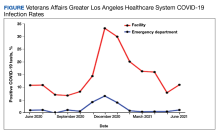COVID-19 Incidence After Emergency Department Visit
Background: The emergency department (ED) at the Veterans Affairs Greater Los Angeles Healthcare System (VAGLAHS) saw a decrease in the number of visits during the early stages of the COVID-19 pandemic. Little is known whether risk mitigation procedures may help reduce the spread of COVID-19 infections for veterans visiting the ED. Therefore, we reviewed patient visits to the ED for diagnoses other than COVID-19 to assess whether these patients had an increased COVID-19 positivity rate within 21 days of the initial visit.
Observations: Risk mitigation procedures instituted by the VAGLAHS ED included a COVID-19 outdoor testing tent, immediate isolation of persons under investigation for COVID-19, disinfection protocols between high-risk patient encounters, dedicated training in donning and doffing personal protective equipment, implementation of 2-physician airway teams for COVID-19 intubations, use of electronic tablets to communicate with COVID-19 patients, and implementation of social distancing initiatives in the waiting room to minimize COVID-19 exposures. The average positivity rate at the VAGLAHS ED during this time frame was 0% to 6.7%, compared with 6.9% to 33.3% within the wider VAGLAHS.
Conclusions: Implementing risk mitigation procedures in the VAGLAHS ED helped minimize exposure and subsequent diagnosis of COVID-19 for veterans who visited the VAGLAHS ED for symptoms not associated with COVID-19 infection. Seeking acute medical care in the ED did not put patients at higher risk of contracting COVID-19.
Program Description
As a quality improvement measure, the
Patients with specific symptoms noted during triage, such as those associated with COVID-19 diagnosis, respiratory infections, fever, and/or myalgias, were isolated in their own patient room. Electronic tablets were used for persons under investigation and patients with COVID-19 to communicate with family and/or medical staff who did not need to enter the patient’s room. Two-hour disinfection protocols were instituted for high-risk patients who were moved during the course of their treatment (ie, transfer to another bed for admission or discharge). All staff was specifically trained in personal protective equipment (PPE) donning and doffing, and 2-physician airway teams were implemented to ensure proper PPE use and safe COVID-19 intubations.
COVID-19 Infections
Electronic health records of patients who visited the VAGLAHS ED for symptoms not related to COVID-19 were reviewed from
A total of 8708 patients who came to the ED with symptoms not associated with COVID-19 infection and had a COVID-19 test within 21 days of the ED visit met the inclusion criteria. The overall average positivity rate at the VAGLAHS ED for symptoms not associated with COVID-19 infection was 1.1% from June 1, 2020, to June 30, 2021. The positivity rate by month ranged from 0% to 6.7% for this period (Figure).
Discussion
Implementing COVID-19 mitigation measures in the VAGLAHS ED helped minimize exposure and subsequent infection of COVID-19 for veterans who visited the VAGLAHS ED with symptoms not associated with COVID-19 infection. Contextualizing this with the overall average monthly positivity rate of veterans in the VAGLAHS catchment area (10.9%) or Los Angeles County (7.9%) between June 1, 2020, to June 30, 2021, veterans who visited the VAGLAHS ED for symptoms not associated with COVID-19 infection were less likely to test positive for COVID-19 within 21 days (1.1%), suggesting that the extensive measures taken at the VAGLAHS ED were effective.8







